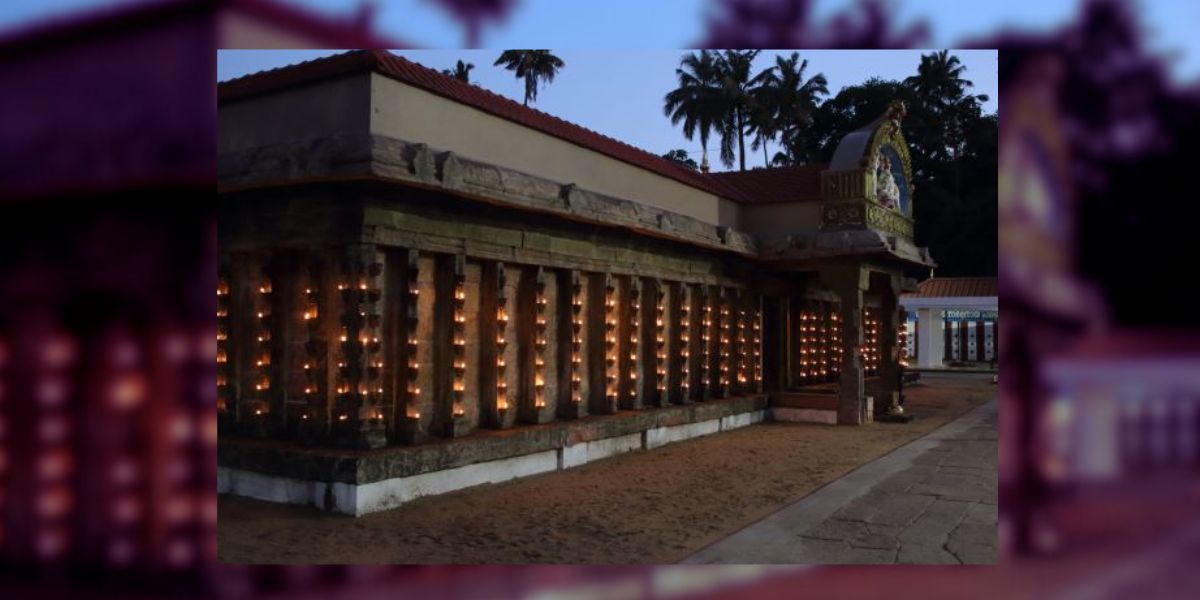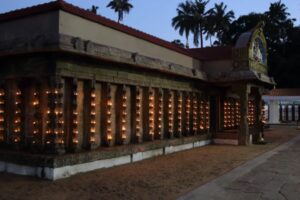Indu Chinta's second book, Iconography of Deepam, delves into the functional richness of traditional oil lamps and also explores its cultural and spiritual significance.

The book, Iconography of Deepam, delves into the functional richness of traditional oil lamps. (Indu Chinta)
It is the holy month of Karthik; a time in the Hindu calendar when the lighting of oil lamps is considered auspicious. Like the rest of the country, Karthik is considered holy in Kerala too. But did you know that the first Lakshadeepam in the state dates back to as early as 1750. It was first celebrated by Maharaja Marthanda Varma in the renowned Sree Padmanabhaswamy temple.
Did you know that there are 33 different kinds of vilakku (lamp) handcrafted in Kunhimangalam in Kannur? Here, artisans chant a specific dhayana sloka (verses for meditation) for each one of them during its making.
Well, these are just a few valuable insights shared by Indu Chinta in her second book, Iconography of Deepam. Published in October 2023, the book delves into the functional richness of traditional oil lamps. It also explores its cultural and spiritual significance.
Replete with evocative sketches and striking photographs, the book highlights the centrality of the lamp in not just temples and homes but also in the realm of performance arts, like Kutiyattam, Kathakali, Tholpavakoothu and Mudiyettu.
“Nowhere have I seen the tradition of creating and using oil lamps as well-preserved as it is in Kerala. From the smallest village shrine in Pulpally, Wayanad to the Sree Padmanabha Swamy Temple in Trivandrum, this is a ritual that has persisted across the state. And this, despite threats from electricity, kerosene and candles. The tradition of deeparadhana (lamp worship) is simply soul-stirring. You can see both the beauty and complexity of faith through the lamp,” shares Chinta.
The book introduces the ubiquity of the ritual of lighting the oil lamp, morning and evening, in an attempt to look inward and invoke the divine.
The familiar fragrance of the oil, the burning of the wick and the sight of the warm glow are all-pervading. Whether one lights the Brindavanadeepam (lamp in front of the Tulsi plant), or the naranga vilakku (lemon lamp) at the Attukal Bhagavathy temple in Thiruvananthapuram or the Balideepam (a lamp lit at the sacrificial altar).
The book essays facts about the ritual of donating lamps at the Valmiki Ashram in Pulpall in Wayanad district. Despite the large number of nilavilakkus (floor lamps), nothing ever gets stolen.
The classification of lamps into suspension, stationery and portable lamps is well elucidated. The book also mentions the significance of the Vriksha (tree) vilakku also called aluvilakku (al refers to the sacred banyan tree) with its leaves acting as mini lamps. This is in reference to the Chettikulangara Bhagavathi Temple in Alappuzha district which houses the largest aluvilakku with a whopping 1001 wicks.
The book highlights the centrality of the lamp in not just temples and homes but also in the realm of performance arts. (Indu Chinta)
There is also an insightful interpretation comparing the seven levels of the quintessential Nilavilakku to the seven chakras of the human body. This has been explained by Vishnu Namboothiri, a former chief priest at Sabarimala.
The book mentions a reference to the sculptures of the Lakshmideepa inside the Sreebelipura corridor of the Sree Padmanabhaswamy temple. It also illustrates details of the Deeparadhana in the temple along with the sequence of portable lamps used.
Chinta also throws light on the significance of the oil lamp in festivals like the Lakshadeepam, Bhadradeepam. Ashtami of Vaikom and the famous Makaravilakku in Sabarimala.
The legendary Vadavilakku of the Ettumanoor Shri Mahadeva temple which is believed to be burning for the last four hundred years is also noteworthy. The lamp today is connected to a motorised tank with a capacity of 4000 litres to circulate the overflowing oil.
There’s extensive mention of the role of the oil lamp in native art forms like Kutiyattam, Kathakali, Tholpavakoothu, and Mudiyettu.
Gathering inputs from Margi Madhu, a prominent artist of Kutiyattam, which is a nearly 2000-year-old theatre tradition, the book reveals how the nilavilakku occupies a central position on the stage.
This positioning lends a rather mystical three-dimensional light and shadow element which enhances the essence of the main performance.
Narrating the importance of the three wicks, the author details the sequence in which it is lit and other unique customs associated with the lamp.
Similar details about the Attavilakku or Kalivilakku used in Kathakali forms are highlighted. Chinta especially focuses on how the lamp acts as a focal point for the artistes during the entire course of the performance. It is also known to improve the concentration of the artistes.
The book also throws the spotlight on the ancient craft of lamp-making with inputs from the artisans in the traditional lamp-making centres of Kunhimangalam and Payyanur in Kannur.
Mannar in Alappuzha and Irinjalakuda in Thrissur are other places in the state where lamps are made.

The book introduces the ubiquity of the ritual of lighting the oil lamp, to invoke the divine. (Indu Chinta)
Like most handicrafts, this one too is a skill that is passed on orally from generation to generation. However, the number is dwindling.
For example, according to the book, in Kunhimangalam there were about 80 families practising metal art a few decades ago. Now, the number is an abysmal ten.
“However, it is heartening to see that the youngsters who are invested in the craft are dedicated and leveraging the power of social media to promote the craft,” adds Chinta.
The difference between a handmade and factory-made lamp is also sufficiently elucidated.
“I have covered a good diversity of cultural and ritualistic systems across the state. But, I would have loved to explore temple lamps in the northern part of the state in more detail,” says the engineer-turned-author, who is working on her next book themed on Theyyam.
Iconography of Deepam is available on Kairali Books and Amazon.

Jul 26, 2024

Jul 26, 2024

Jul 25, 2024

Jul 25, 2024

Jul 25, 2024

Jul 24, 2024